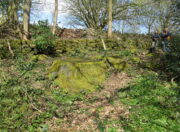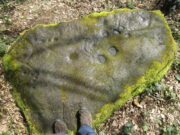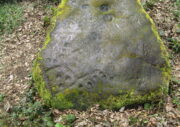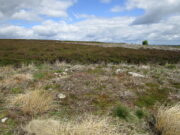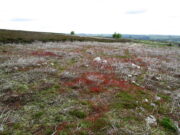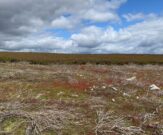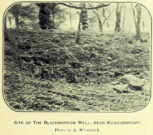Cup-and-Ring Stone: OS Grid Reference – SE 24602 40614
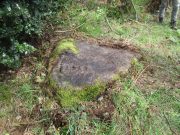
Follow the same directions as if you’re visiting the Gab Woods (1) carving—which you’re probably visiting if you’re checking this one out. Walk south into the middle of the woods and you’ll soon notice the road/houses on the other side of the trees. Once here, staying in the woods, follow the walling down for about 100 yards, keeping your eyes peeled for a reasonably large flat stone about 15 yards from the wall in the trees. If you can’t find it at first, patiently zigzag back and forth until it eventually appears!
Archaeology & History
One of two known petroglyphs in this woodland (there may be more hidden away) that was first found in the 1940s by Dan Cole. The main feature here consists of a cup-mark encircled by two large, well-defined oval-shaped “rings”, a bit like a large eye. From the central cup, a long carved line runs down the gently sloping surface of the stone and, roughly halfway down from the cup-and-ring to the edge of the stone, another carved line cuts across at rough right-angles, giving the carving a slight anthropomorphic (human-like) appearance when looking up the stone. This humanesque figure may have been the intention—though for my part I have to say that I’m slightly skeptical about it. We may never know either way. Several other single cups are on the stone: one to the side of the large “eye” and two or three below the elongated “arms.”
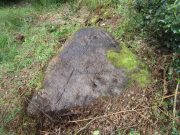
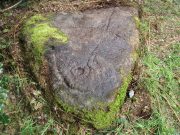
An additional, interesting non-petroglyphic feature is the name of the woodland in which the stone resides. In Thomas Wright’s massive dialect work, Gab is a northern dialect word meaning “to talk”, or “idle chatter” (and variants thereof); this is echoed in Blakeborough’s (1911) Yorkshire survey; and Wilkinson’s (1924) local study tells simply it’s “idle talk…able to talk glibly and with much plausibility—a Town Hall Square orator for instance.” This makes the place as something akin to being “the woodland that talks”, “the chattering woods” or “the talking woodland”, etc. You can make up your own mind as to what this might mean… *
References:
- Blakeborough, Richard, Wit, Character, Folklore and Customs of the North Riding of Yorkshire, W. Rapp: Saltburn 1911.
- Wilkinson, John H., Leeds Dialect Glossary and Lore, privately published: Leeds 1924.
- Wright, Joseph, English Dialect Dictionary – volume 2, Henry Frowde: London 1900.
Links:
Acknowledgements: Huge thanks must go to Peter Murphy for recovering this impressive carving from the archives, and from beneath the carpet of soil and vegetation, so enabling it to see the light of day once again. Also big thanks to the usual culprit of James Elkington, as well as Sarah Walker and Sarah Jackson.
* a Scottish dialect variant of gab relates to the mouth, tongue, taste.
© Paul Bennett, The Northern Antiquarian
